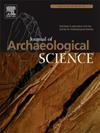Sequential multi-isotope sampling through a Bos taurus tooth from Stonehenge, to assess comparative sources and incorporation times of strontium and lead
IF 2.6
1区 地球科学
Q1 ANTHROPOLOGY
引用次数: 0
Abstract
The aim of this paper is to use the sequential nature of enamel deposition in hypsodont teeth to study the relationship, in time and source, of strontium and lead isotopes to better understand the use of this pairing of elements for studies of movement and migration. Carbon and oxygen isotope analysis were included to place the data in their seasonal and dietary context. The study was undertaken on an M3 from a Neolithic cattle tooth excavated from Stonehenge. The animal was female based on peptide analysis. The tooth records c. six months of enamel deposition from winter to summer, based on δ18OcarbVSMOW compositions, and changes in δ13CcarbVSMOW that reflect a shift from forest to grassland food sources. 87Sr/86Sr varies from a winter value of 0.7144 to 0.7110 in summer. Lead concentrations and isotope composition shows peaks and troughs which contrast with the unidirectional change in the 87Sr/86Sr. We suggest that whereas the Sr is wholly derived from dietary sources the Pb represents a balance between diet and skeletal reservoirs, the latter being scavenged during a time of metabolic stress attributed to calving and lactation. It is thus important to consider skeletal reservoirs as a source of Pb when using this element to track movement and migration. This study demonstrates the value of using the complementary isotope systems of lead and strontium in tandem, but also highlights that their integration must be undertaken with caution and with full consideration of alternative drivers of variation.
对巨石阵上的一颗金牛牙齿进行连续多同位素采样,以评估锶和铅的比较来源和结合时间
本文的目的是利用下尖牙釉质沉积的顺序性质,研究锶和铅同位素在时间和来源上的关系,以更好地理解这对元素在运动和迁移研究中的应用。碳和氧同位素分析包括在他们的季节和饮食背景下放置数据。这项研究是对从巨石阵出土的新石器时代牛牙的M3进行的。经多肽分析,该动物为雌性。根据δ18OcarbVSMOW的组成和δ 13carbvsmow的变化记录了从冬季到夏季6个月的牙釉质沉积,反映了食物来源从森林到草原的转变。87Sr/86Sr在冬季为0.7144 ~夏季为0.7110。铅浓度和同位素组成呈现波峰和波谷,与87Sr/86Sr的单向变化形成对比。我们认为,尽管Sr完全来源于饮食来源,但Pb代表了饮食和骨骼储存库之间的平衡,后者在产犊和哺乳期代谢应激期间被清除。因此,当使用铅元素来追踪铅的移动和迁移时,考虑骨骼储层作为铅的来源是很重要的。这项研究证明了串联使用铅和锶互补同位素系统的价值,但也强调了它们的整合必须谨慎进行,并充分考虑变化的替代驱动因素。
本文章由计算机程序翻译,如有差异,请以英文原文为准。
求助全文
约1分钟内获得全文
求助全文
来源期刊

Journal of Archaeological Science
地学-地球科学综合
CiteScore
6.10
自引率
7.10%
发文量
112
审稿时长
49 days
期刊介绍:
The Journal of Archaeological Science is aimed at archaeologists and scientists with particular interests in advancing the development and application of scientific techniques and methodologies to all areas of archaeology. This established monthly journal publishes focus articles, original research papers and major review articles, of wide archaeological significance. The journal provides an international forum for archaeologists and scientists from widely different scientific backgrounds who share a common interest in developing and applying scientific methods to inform major debates through improving the quality and reliability of scientific information derived from archaeological research.
 求助内容:
求助内容: 应助结果提醒方式:
应助结果提醒方式:


